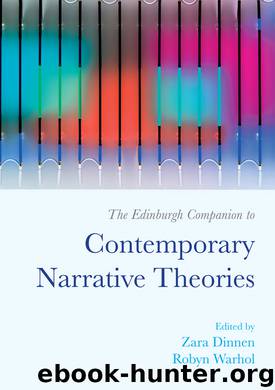The Edinburgh Companion to Contemporary Narrative Theories by Zara Dinnen Robyn Warhol

Author:Zara Dinnen,Robyn Warhol
Language: eng
Format: epub
Publisher: Edinburgh University Press
Conclusion
The interface is usually invisible or taken to be inevitable and unchanging in other media. Often it only becomes visible when there is some kind of material breakdown in the text or its presentation apparatus. Before the era of digital projection, when we watched a film the time of the UI moved forward consistently and unnoticed – unless the film broke and the audience had to sit and wait for it to be restarted. The smooth temporal movement of reading a book only comes into question when pages are torn out or scrambled. Of course, many artistic experiments with the form of the book were designed precisely to draw our attention to what we can call the UI of traditional reading, from the somewhat baffling multi-column printing of Steve Katz’s The Exagggerations of Peter Prince (1968) to the postcard design of Robert Filliou’s Ample Food for Stupid Thought (1965). Recent digital versions of the film or book draw our attention to this overlooked interface. Modern computer-based DVD film systems introduce a UI at the top level of the disk menu, allowing viewers to jump to a particular scene, modify the audio, or restart the film from the beginning. Likewise, the time of reading becomes more visible in ebook readers. Amazon’s Kindle, for example, estimates the remaining reading time in a chapter based on previous page turns.
These digital translations encourage us to ask what relevance the concept of UI time might have to pre-digital, non-experimental texts.11 In retrospect, we might recognise that print has always been able to impose time on the process of reading through, for example, serial publication. Of course, modern books have many UI elements in the form of paratextual features like the table of contents and index, as well as user-created interface elements like bookmarks and dog-eared pages. But we tend to take these features for granted and overlook the influence that these have on the temporality of our reading. Recent work in comparative media studies has drawn attention to features of print that in the past were taken for granted. As N. Katherine Hayles and Jessica Pressman write, ‘As the era of print is passing, it is possible once again to see print in a comparative context with other textual media, including the scroll, the manuscript codex’, and many others (2013: vii).
UI time, then, is central to digital narrative but encourages us to revisit the material construction of other media and to consider how those conditions shape the temporality of our reading experience. The centrality of idleness and waiting to the digital text likewise invites us to reconsider our common models for the temporality of reading and to attend more closely to our typical engagement with these material objects.
Download
This site does not store any files on its server. We only index and link to content provided by other sites. Please contact the content providers to delete copyright contents if any and email us, we'll remove relevant links or contents immediately.
4 3 2 1: A Novel by Paul Auster(11788)
The handmaid's tale by Margaret Atwood(7446)
Giovanni's Room by James Baldwin(6806)
Asking the Right Questions: A Guide to Critical Thinking by M. Neil Browne & Stuart M. Keeley(5355)
Big Magic: Creative Living Beyond Fear by Elizabeth Gilbert(5349)
Ego Is the Enemy by Ryan Holiday(4953)
On Writing A Memoir of the Craft by Stephen King(4659)
The Body: A Guide for Occupants by Bill Bryson(4579)
Ken Follett - World without end by Ken Follett(4441)
Bluets by Maggie Nelson(4258)
Adulting by Kelly Williams Brown(4231)
Eat That Frog! by Brian Tracy(4147)
Guilty Pleasures by Laurell K Hamilton(4115)
White Noise - A Novel by Don DeLillo(3828)
The Poetry of Pablo Neruda by Pablo Neruda(3813)
Fingerprints of the Gods by Graham Hancock(3731)
Alive: The Story of the Andes Survivors by Piers Paul Read(3726)
The Book of Joy by Dalai Lama(3693)
The Bookshop by Penelope Fitzgerald(3615)
